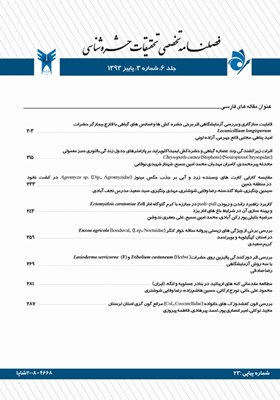بررسی اثر دور کنندگی پالیزین روی حشرات (Tribolium castaneum (Herbst و Lasioderma serricorne با سه روش آزمایشگاهی
محورهای موضوعی : حشره شناسی و سایر بندپایان
1 - گروه حشره شناسی و بیماری های گیاهی، پردیس ابوریحان دانشگاه تهران، پاکدشت
کلید واژه: Lasioderma serricorne, Tribolium castaneum, پالیزین, دورکنندگی, لوله باسوین, Lasioderma serricorne, Palizin ®, Repellent, Y- shape Busvine,
چکیده مقاله :
برای کاهش جمعیت حشرات آفت محصولات انباری معمولا از آفت کش ها استفاده می گردد اما این ترکیبات به دلیل داشتن اثرات سمی بر روی موجودات غیر هدف و همچنین به دلیل بروز مقاومت در حشرات و داشتن باقی مانده روی محصولات توصیه نمی گردند، لذا در چنین شرایطی انجام تحقیقات برای یافتن روش مناسب، ایمن و مقرون به صرفه ضروری به نظر می رسد. از این رو استفاده از ترکیبات دورکننده حشرات را می توان به عنوان یک روش کنترل جدید در انبارها در نظر گرفت. در این تحقیق برای بررسی اثرات دورکنندگی عصاره تجاری اکالیپتوس (پالیزین) روی Tribolium castaneum و Lasioderma serricorne ، لارو و حشرات کامل فوق در معرض غلظت های 5/0، 1، 5 و 10 درصد پالیزین قرار گرفتند. آزمایشات با سه روش پتری دیش، لوله Y شکل باسوین و لیوان های متخلخل انجام شد. در هر سه روش بیشترین میزان دورکنندگی مربوط به غلظت 10 درصد پالیزین بود که برای T. castaneum به ترتیب برابر با 87/78، 27/74 و 93/56 درصد و بیشترین میزان دورکنندگی برای L. serricorne به ترتیب برابر با 70/72، 86/85 و 60/ 45 درصد برای روش پتری دیش، لوله باسویه و لیوان های متخلخل بود.
To alleviate insect pest problems in storage, synthetic pesticides are recommended, but their use may create toxicity to non-target organisms, development of resistance and residues in treated products. Under such circumstances the need for research to find a safe, convenient, durable and economically logical method is necessary. The application of repellents could be considered as a new control method in storage. In this study the repellency effect of Coconut soap (Palizin®) was assayed on Tribolium castaneum (Herbst) and Lasioderma serricorne (F.). Adults and larvae of T. castaneum and L. serricorne exposed to 0, 0.5, 1, 5 and 10% concentration of Coconut soap (Palizin®) (botanical compound) using three techniques such as: filter papers, Y- shape Busvine tube and leaky glass bioassays. In each of three methods, the maximum repellency effect of Coconut soap (Palizin®) was in concentration of 10%, and, the quantities were equal to 78.87, 74.27 and 56.93% for adults of T. castaneum and 72.70%, 85.86% and 45.60% for L. serricorne in Petri-dish, Y- shape Busvine tube and leaky glass techniques respectively.


